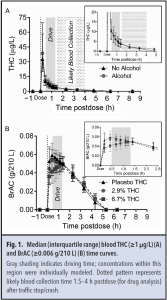 Two recent research reports explain why blood tests are ineffective for determining driving impairment by marijuana, and why impairment-based DUI per se blood level limits for marijuana are useless.
Two recent research reports explain why blood tests are ineffective for determining driving impairment by marijuana, and why impairment-based DUI per se blood level limits for marijuana are useless.
Rebecca Hartman’s team (R.L. Hartman et al. http://dx.doi.org/10.1016/j.drugalcdep.2015.06.015 ) led the groundbreaking Iowa driving simulator study that showed, “During drive blood THC ≥8.2 ?g/L increased SDLP similar to notably-impairing alcohol concentrations.” She followed up with a report in Clinical Chemistry this year (R.L. Hartman et al. DOI: 10.1373/clinchem.2015.248492) which showed that the decay of THC in blood after smoking marijuana was so rapid that blood tests taken after driving could not represent the THC level at the time of driving. “Forensic blood THC concentrations may be lower than common per se cutoffs despite greatly exceeding them while driving. Concentrations during driving cannot be back-extrapolated because of unknown time after intake and interindividual variability in rates of decrease.”
Unlike alcohol’s gradual and linear decay in blood, THC’s decay is rapid, non-linear, and highly variable from one individual to another. Hartman found, for example, that within 25 minutes after beginning to smoke marijuana, a smoker’s THC blood level declined an average of 73.5%, with a range between 3.3% and 89.5%. Fig 1 from her report clearly shows the difference in decay rates between THC and alcohol in the same subjects.
In her research setting, Hartman and colleagues were able to measure blood THC levels before and after driving, and then interpolate what the THC level likely was during the test driving period.
Officers enforcing DUI laws don’t have that luxury.
This author published a research report (E.Wood, A. Brooks-Russell, P. Drum. Traffic Injury Prevention 2016, Vol 17, No 2, 105-108) that measured the time after dispatch of a police officer to the scene of a crash involving death or serious bodily injury, before blood was drawn for a forensic test. “The average time from law enforcement dispatch to blood draw in cases of vehicular homicide and vehicular assault was 2.32 h (SD ± 1.31 h), with a range of 0.83 to 8.0 h and a median of 2.0 h.” We concluded that, “Given the current delays to blood testing in cases of arrests for vehicular homicide and vehicular assault in Colorado, many blood tests are unlikely to confirm that drivers who are impaired from smoking marijuana have THC levels above established legal limits.”
We will present these results at the Lifesaver’s Conference in Long Beach, California. Perhaps by getting the facts out, we can convince legislators in other states of the folly of following the lead of Colorado and Washington, two states now paying the price of establishing a 5 ng/ml THC driving limit.
